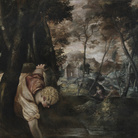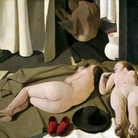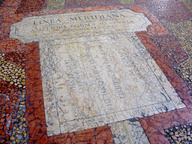Claire Fontaine

© Claire Fontaine
From 23 Giugno 2016 to 07 Agosto 2016
Rome
Place: Museo Pietro Canonica Villa Borghese
Address: via Pietro Canonica 2
Times: Tuesday to Sunday from 1 to 7pm (ticket office closes at 6,30pm)
Responsibles: Pier Paolo Pancotto
Organizers:
- Roma Capitale - Sovrintendenza Capitolina ai Beni Culturali
Ticket price: free entrance
Telefono per informazioni: +39 060608
Official site: http://www.museocanonica.it
First ever exhibition of the collective in a public institution in Rome, the project by Claire Fontaine at Museo Pietro Canonica is part of a series of exhibitions titled Fortezzuola, and sponsored by Roma Capitale – Sovrintendenza Capitolina ai Beni Culturali. Conceived and curated by Pier Paolo Pancotto, the project aims to stimulate reflections on the relationship between the protagonists of today’s international art scene and Italy, and offers to the public the opportunity to engage for the first time ever with works by artists that are not properly represented, if not completely absent, in the Italian contemporary art context. Nowadays, many foreign practitioners confront themselves with the Italian cultural and historical heritage, facilitating a renewal and reinterpretation of the Italian tradition, of its canons and modalities of production. Each artist is invited to realise an original intervention, designed and produced site-specifically in relation to the historical and structural characteristics of the museum’s galleries, thus following the guidelines of Fortezzuola project. After several stays in Rome, Claire Fontaine has conceived a project that has surely been inspired by the historical and cultural context of Museo Canonica, but that is also based on one of the most recurrent expressive tools in the duo’s artistic practice: the ready made. The project unfolds in a series of interventions spread over the museum’s galleries. The link between these interventions is the portrait, a clear homage to Pietro Canonica who has focussed his whole artistic production on portraiture. Nevertheless, this theme here functions also as a pretext to further reflect on sculpture making, and on the significance that this art has today, especially when displayed in relation with a specific institutional context. Therefore, these portraits by by Claire Fontaine take the form of series of installations from the duo’s series known as Living Statues. These oeuvres reference the vernacular and popular register of amateur performances taking all the world’s touristic areas as stage. Through cross-dressing and immobility, the actor plays the role of a sculpture. Claire Fontaine’s conceptual rift allows the collective to evoke with these works the same kind of performance, yet highlighting its paradoxical turn: indeed, these are objects pretending to be subjects playing the role of objects. Such reflection arises from the collective’s researches around the ready made, and its consequences on the subjectivity of artists who today experience the reification of nature and the humanisation of things. Additionally, these oeuvres crystallise exemplarily the link between Claire Fontaine’s practice and the legacy of institutional critique, for they claim that the contemporary museal experience is a fundamentally touristic experience. It is so because it is produced by the ambitions of the institutions willing to reach an always greater public, but it is also the result of the expectations and needs of that public that eventually walk through the museum’s rooms. The three characters Claire Fontaine realises for this intervention at Canonica have a mythical and allegorical aspect. Two of them seem to levitate, but only because of a metal structure that keeps them up (the same structure that is currently used by most of the street performers playing the role of living statues). Yoda, the wise Jedi Master in Star Wars represents the monstrous intelligence that has yet been ridiculed by the stereotypes of a popular culture that George Lucas sapiently translated into a peculiar character that is both human and animal, both old and young. He is a key figure of that war he belongs to, and in the museum he will force the viewer to a different and even audacious look at the monuments celebrating war and military leaders that are part of the museum’s collection. Another work, a mature and bold Pinocchio functions as an ambiguous representation of the grown man in the contemporary era. He is sinister and pathetic at the same time, and his humanity cannot hide the immoral monstrosity of the long nose of the baby-marionette, although here this nose takes a more sexual turn. His dishonesty comes from his inner nature, and no metamorphosis could ever change that. Called after the cyber-revolutionary international collective that has taken it over to give itself an identity, Anonymous is a mask that has been created in order to represent the face of Guy Fawkes who in 1605 tried –unsuccessfully- to kill King James at Westminster Palace. Since then, his mask has been put every year on a straw puppet dressed as the protester, before setting it on fire. Recently, it has been worn by rebels and revolutionaries of different parts of the world in order to protect their identities during strikes and protests. Here, Guy Fawkes will become an anonymous character, without any specific age, gender or political beliefs: the only thing we can recognise in him is his keenness on escaping the current repressive and antidemocratic surveillance policies. Like Martin Soto Climent, Alfredo Aceto and Claire Tabouret, Tillman Kaiser, Claire Fontaine creates a site-specific visual journey produced through quite a performative approach (working every day in the museum’s galleries, letting the suggestions stimulated by the place play freely).The outcome of this approach will be known at the end of the process, that coincides with the opening of the exhibition. This aspect will be particularly emphasised in the interventions made in the first floor and in the storage rooms of the museum. These interventions too will revolve around the concept of ‘identity’ and the various visual solutions through which identity becomes evident. Being undeniably one of such solutions, sculpture has played a key role in the life-long creative research of Pietro Canonica himself.
Claire Fontaine (collective founded in 2004 and based in Paris). Solo Exhibitions (selection): The Jewish Museum, New York (2013); Frac Haute Normandie (2013); Frac Provence-Alpes-Cote d’Azur (2013); Museion, Bolzano (2012); Museum of Contemporary Art, Miami (2010); Witte de With, Rotterdam (2008); Palais de Tokyo, Paris (2007); Kunsthalle, Zurigo (2007) Group Exhibitions (selection): AV Festival, Newcastle (2016); Punk. Sus rastros en el arte contemporáneo, MacBa, Barcellona (2016), Signori prego si accomodino, Venezia, Casa Scatturin (2015); Food, Mucem, Marseilles (2014); The Crime Was Almost Perfect, Witte de With, Rotterdam (2014); Relaunch, KW Institute, Berlin (2013); Showing Its Colours, Marta, Herford, (2013); Manifesta 9, Genk, Limburg (2012); Contemplating the Void, The Guggenheim Museum, New York (2009); Fax, The Drawing Center, New York (2009); Manifesta 7, Rovereto (2008).
The exhibition is realised in collaboration with T293 gallery, Rome.
SCARICA IL COMUNICATO IN PDF
COMMENTI

-
 Dal 22 febbraio 2025 al 29 giugno 2025
Forlì | Museo Civico San Domenico
Dal 22 febbraio 2025 al 29 giugno 2025
Forlì | Museo Civico San Domenico
-
 Dal 21 febbraio 2025 al 29 giugno 2025
Rovigo | Palazzo Roverella
Dal 21 febbraio 2025 al 29 giugno 2025
Rovigo | Palazzo Roverella
-
 Dal 21 febbraio 2025 al 27 aprile 2025
Roma | Palazzo Doria Pamphilj
Dal 21 febbraio 2025 al 27 aprile 2025
Roma | Palazzo Doria Pamphilj
-
 Dal 26 febbraio 2025 al 20 luglio 2025
Bologna | Palazzo Pallavicini
Dal 26 febbraio 2025 al 20 luglio 2025
Bologna | Palazzo Pallavicini
-
 Dal 15 febbraio 2025 al 29 giugno 2025
Milano | Palazzo Reale
Dal 15 febbraio 2025 al 29 giugno 2025
Milano | Palazzo Reale
-
 Dal 14 febbraio 2025 al 14 settembre 2025
Roma | Chiostro del Bramante
Dal 14 febbraio 2025 al 14 settembre 2025
Roma | Chiostro del Bramante


